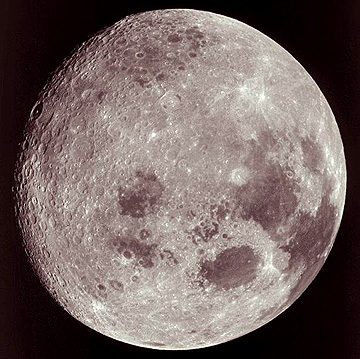Once established, the trick is to interpret these albedo values. Albedos of various likely surface materials can be measured on Earth in the laboratory, where textures and illumination conditions can also be varied. In this way, lunar scientists postulated that the maria were some type of volcanic material, most likely basalt. The highlands were more enigmatic. Several other volcanic types could produce albedos in the proper range, but uncertainties about particle size and other variables inhibited definitive identification. The problem was resolved with the first unmanned Landers, the five Surveyors described later. The answer was that the highlands included a different group of rock types, of which anorthosite is prevalent, containing larger amounts of light-colored feldspars. The albedo values for both maria and highlands were judged to be consistent with scattering by granular or fragmental textures associated with unconsolidated surface materials, subsequently borne out after the Surveyor landings were normal (some thought the craft would even sink into loose, almost powdery rock debris which, fortunately,didn't happen).
The total intensity or brightness of reflecting surfaces at specific points or areas varies with the phases of the Moon (progressive waxing and waning owing to changing illumination depending on relative positions of the Sun, Earth, and Moon). This is defined by the lunar photometric function, a plot of intensity versus phase angle. The degree of polarization of light from the Moon also shifts with phase angle and can show considerable variations in different regions of the Moon, again related to composition and textural changes.
Even before the pre-Apollo and Apollo programs, the Moon was examined in the multispectral mode (recent example illustrated on p. 19-6). The simplest approach was to use photofilters that pass limited spectral ranges. Thus, the Moon has been examined in the UV, blue, green. red, IR and other spectral intervals. This technique brings out variations in color shades that appear to distinguish different surface units. Some maria tend to have stronger blue components; other are more reddish. Differences between maria and highlands are accentuated. These subtle variations are related to the influence of elements like calcium, iron and titanium on the behavior of reflected light at different wavelengths. More exacting measurements have been made by passing the light through a spectrometer which can provide semiquantitative estimates of variations in percentages of several of the common elements. Higher values for iron, magnesium, and calcium supported the surmise that lunar rocks were most probably of basic (silica-low; Fe/Mg-rich) igneous composition.
The astronauts orbiting the Moon described its color as dominantly medium to dark grays with tan overtones. Many pictures of the lunar surface have been obtained starting with unmanned pre-Apollo missions, then numerous Apollo shots, and, afterwards, a series of images sent back by the Galileo spacecraft as it orbited our satellite before leaving for its rendezvous with Jupiter and then by the Clementine orbiter (p. 19-6). A typical natural color image of the full Moon, taken from the Apollo 17 Command Module, shows much of the farside (some have called this the "backside" but its connotation rules this out) and part of the eastern limb visible from Earth (maria include Smythii, Marginis, Crisium (near circular), Fecunditatis, and part of Tranquillitatis [site of first Apollo {11} landing]).

Prior to the landings, as early as 1946 radar had provided further images of the full Moon and selected regions. Sent from Earth transmitters, signals are returned as polarized backscatter in which time delays and Doppler frequency shifts are measured. Here are three mosaics in Mercator (top), Lambert Conformal, and Polar Stereographic projections made from reflections of 3.8 cm pulses sent by M.I.T.ís Haystack Observatory:
Earth-based thermal emission images can be acquired by infrared scanners operating through telescopes. The ideal time to sense the full Moon is during a total eclipse:
Under this condition, bright areas called "hotspots" will appear; many associated with large lunar craters. These often contain dark lavas that absorb solar radiation (black body effect; see Section 9) and re-emit as higher radiant temperatures. During such times, observers also look for "lunar transients" (localized short-lived bright, often reddish glows visible to the eye) that some believe are evidence of volcanic activity and other thermal phenomena ; there have been claimed sightings of these even when the Moon is normally illuminated, particularly in the shadowed areas (dark phases)
Code 935, Goddard Space Flight Center, NASA
Written by: Nicholas M. Short, Sr. email: nmshort@epix.net
and
Jon Robinson email: Jon.W.Robinson.1@gsfc.nasa.gov
Webmaster: Bill Dickinson Jr. email: rstwebmaster@gsti.com
Web Production: Christiane Robinson, Terri Ho and Nannette Fekete
Updated: 1999.03.15.